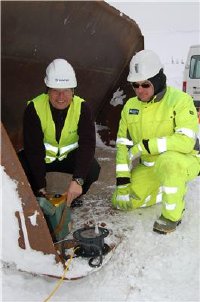Mar 16 2010
The Svelvik Ridge in southern Norway could quite literally become a green laboratory later this year: a unique tool for scientists who are developing the technology needed for secure underground storage of captured CO2.
 Norway’s Minister of Petroleum and Energy, Terje Riis-Johansen (to the left), visited the laboratory site while seismic investigations were done. Here accompanied by blasting expert Kjetil Morstad. Photo: SINTEF
Norway’s Minister of Petroleum and Energy, Terje Riis-Johansen (to the left), visited the laboratory site while seismic investigations were done. Here accompanied by blasting expert Kjetil Morstad. Photo: SINTEF
Norway’s Minister of Petroleum and Energy, Terje Riis-Johansen, recently visited the site to watch seismic investigations that are now being done at Hurum as part of the pilot study.
The idea is to establish a field laboratory at the Svelvik Ridge in Hurum outside Oslo, that can test current methods for monitoring how the CO2 behaves deep below the surface at different storage sites, and thereby contribute to the development of regulations and procedures for CO2 storage monitoring.
With SINTEF – the largest independent research organisation in Scandinavia – acting as project manager, Norwegian, French and British scientists from both academia and industry are launching a geological pilot study that will determine whether the Hurum site is suitable for experiments of this sort, and whether implementing the plans for a laboratory is justifiable in environmental and safety terms.
“Important to have good methods of monitoring”
“When operations are performed according to the book when CO2 is stored in geological strata, the risk of the gas leaking to the surface is extremely low. However, it is essential to have good methods of monitoring the behaviour of the CO2 once it is stored. That is what our project will help to do,” says project manager Dr. Menno Dillen, a senior scientist at SINTEF Petroleum Research.
The Hurum project is part of the efforts of scientists, industry and the authorities in several countries to develop technology capable of capturing and storing the greenhouse gas CO2 emitted by coal- and gas-fuelled power stations and by other industrial plants.
Unique facility
If the Hurum site is found to be suitable, the scientists will allow the CO2 to move up and seep through the surface of the unpopulated top of the Svelvik Ridge.
“We are talking about small, controlled injections. Precisely because we know how much CO2 will go up through the Svelvik Ridge and when, we will be able to test just how sensitive and accurate existing monitoring and measurement methods are,” says Dillen.
According to SINTEF, no other field laboratory anywhere in the world will simultaneously test so many monitoring methods at such depths as here.
“Our objective is to contribute to monitoring procedures that ensure that undesirable migrations of CO2 will be discovered at an early stage at all storage sites, and that countermeasures can be rapidly implemented,“ says SINTEFs Menno Dillen.